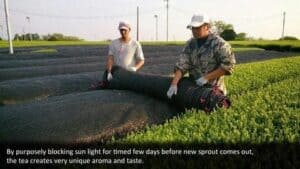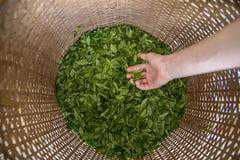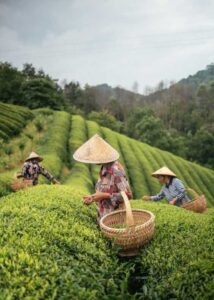
Green tea is at the heart of Japanese culture, where every step of cultivation and preparation is approached with great care and precision. Japanese green tea offers a distinct flavor profile and nutritional benefits that set it apart from tea grown in China or other regions. Here are 10 fascinating insights into Japanese green tea that you might not have known:

1.The First Harvest of the Year: This harvest, occurring between May and June, produces the highest-quality tea leaves. Due to the slow growth during the cold months, these leaves are denser in nutrients, leading to a richer flavor. The first harvest contains three times more L-Theanine than subsequent harvests, giving the tea a naturally sweet and smooth taste.
2. The Second Harvest of the Year: Taking place in June and July, this harvest faces challenges due to the intense heat. The faster-growing leaves are typically more bitter and of lower quality, necessitating stricter control over the harvest process to ensure quality.
3. Kanreisha Curtains (Shade Curtains): To protect tea plants from direct sunlight, a black curtain or shade cover is used for about a month before harvest. This technique enhances the tea’s sweetness by reducing sun exposure. Two types of coverings are common in Japan: direct covering on the plants and awnings above. Some plantations use a combination of both to achieve the best results.
4. Hand vs. Machine Picking: Hand-picked tea leaves are generally of higher quality than those harvested by machine. This is because hand selection allows for a more delicate aroma and refined taste. The optimal time for picking is when there are three to five new buds, ensuring the right balance between maturity and tenderness.
5. Japan’s Tea Production Volume: Despite its deep-rooted tea culture, Japan contributes only 7% of the world’s green tea production. Of this, 95% is consumed domestically, leaving just 5% available for export.
6. Traditional Tea-Picking with Wooden Baskets: While technology and machinery have become more common, many farms still use traditional wooden baskets for tea picking, preserving a method that has been passed down for generations.
7. Preparing the Farm for the Next Harvest: After the final harvest, usually in October and November, tea farmers prune the plants to ensure young leaves grow without mixing with older ones. This step is crucial for maintaining the quality of the next spring’s harvest.
8. Tea Harvest Tourism: In regions like Kyoto, visitors can experience tea harvesting firsthand. Known locally as “Obubu,” this unique form of green tea can cost up to 14,000 yen per kilogram. Farms have welcomed tourists for over 800 years, offering a chance to pick and enjoy tea straight from the source.
9. Caring for Green Tea Plants During Winter: In the colder months, green tea plants require special care to survive. Farmers use straw, dried leaves, and bamboo husks to insulate the plants, providing warmth and helping retain soil moisture. This ensures the plants remain healthy and ready for the next growing season.
10. Harvesting Methods: Japan vs. China: Unlike China, where all the leaves are often harvested at once, Japanese farmers follow a selective harvesting approach, picking specific leaves at different times of the year. This technique allows for better control over the flavor and quality of the tea.
This technique allows for better control over the flavor and quality of the tea.
From the first harvest to winter care, growing green tea in Japan is a year-round process that demands dedication and expertise. Japanese tea farmers invest time and effort to ensure the finest quality, resulting in a tea that embodies the meticulous tradition and rich flavors of Japanese culture.
Source:
https://www.japanesegreenteain.com/blogs/green-tea-and-health/harvesting-green-tea-in-japan-10-surprising-harvesting-things-you-didnt-know





